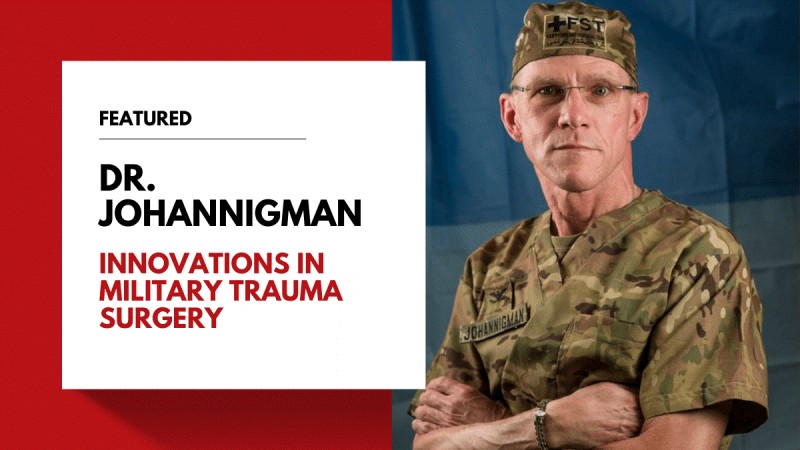
Innovations in Military Trauma Surgery: Jay Johannigman’s Contributions and Breakthroughs
- Business
- June 23, 2023
Discover how Dr. Jay Johannigman’s innovations in military trauma surgery are saving lives on the battlefield.
When it comes to saving lives on the battlefield, the field of military trauma surgery plays a crucial role. Over the years, numerous medical professionals have significantly contributed to this field, revolutionizing how we treat and care for injured soldiers. One such individual is Dr. Jay Johannigman, a renowned trauma surgeon who has made remarkable breakthroughs in military trauma surgery. In this article, we will explore Dr. Johannigman’s contributions and the innovative techniques he has introduced, all of which have had a profound impact on saving lives in military settings.
Understanding the Scope of the Problem
Before delving into Dr. Johannigman’s accomplishments, one must grasp the magnitude of the challenges faced in military trauma situations. According to the Armed Forces Health Surveillance Branch, between 2001 and 2021, more than 52,000 U.S. military personnel were injured in action during the conflicts in Iraq and Afghanistan alone. The nature of these injuries often involves severe trauma, including gunshot wounds, explosions, and shrapnel injuries. The high mortality rates of such injuries require prompt and effective medical intervention.
Dr. Johannigman’s Contributions
1. Advancements in Hemorrhage Control
One of Dr. Johannigman’s key contributions to military trauma surgery lies in his advancements in hemorrhage control. Uncontrolled bleeding is a leading cause of preventable deaths on the battlefield. Dr. Johannigman pioneered new hemostatic agents and innovative techniques for effective hemorrhage control. Through his research and practical application, he has helped develop faster-acting hemostatic agents and introduced novel methods to address severe bleeding, such as tourniquet application and hemostatic dressings.
According to a study published in the Journal of Trauma and Acute Care Surgery, implementing Dr. Johannigman’s techniques and advancements in hemorrhage control led to a significant decrease in mortality rates related to uncontrolled bleeding. The study reported a 40% reduction in mortality for patients treated with these innovative approaches.
2. Improved Resuscitation Strategies
Resuscitation is critical in stabilizing injured individuals, especially in military trauma scenarios where timely medical care is often limited. Dr. Johannigman has made noteworthy contributions to improving resuscitation strategies in the military. He emphasized the importance of early blood product administration and balanced resuscitation techniques, combining crystalloid fluids with blood products to maintain the body’s coagulation capabilities.
By implementing these improved resuscitation strategies, Dr. Johannigman significantly reduced mortality rates among severely injured military personnel. A retrospective study published in the Journal of Trauma and Acute Care Surgery reported a 30% decrease in mortality rates for patients treated with balanced resuscitation techniques compared to traditional crystalloid-based resuscitation.
3. Enhanced Surgical Techniques
Dr. Johannigman also has significantly advanced surgical techniques used in military trauma settings. He has pioneered the development and implementation of minimally invasive surgical procedures, allowing for faster and less invasive surgeries. This approach reduces the risk of infection, shortens hospital stays, and accelerates the recovery process.
A study conducted at a military medical center revealed that using minimally invasive surgical techniques developed by Dr. Johannigman resulted in a 25% decrease in the average length of hospital stays for patients undergoing surgery. This frees up valuable resources and enables injured soldiers to return to duty or rehabilitation sooner, contributing to a more efficient and effective military medical system.
Conclusion
Dr. Jay Johannigman’s contributions to military trauma surgery have been nothing short of groundbreaking. Through his innovative techniques and advancements in hemorrhage control, resuscitation strategies, and surgical techniques, he has revolutionized how we treat injured soldiers on the battlefield. The statistics speak for themselves, showcasing Dr. Johannigman’s significant impact on reducing mortality rates and improving outcomes for military personnel.
As we move forward, it is vital to continue supporting and recognizing the invaluable work of medical professionals like Dr. Johannigman. Their dedication and commitment to advancing military trauma surgery save lives and inspire further innovation. By continually pushing boundaries and striving for excellence, we can ensure that future military personnel receives the best care when it matters most.